
- TOP
- Residential fire prevention measures
Residential fire prevention measures
Residential fire alarm
Reporting a fire


* About the certification mark for residential fire alarm devices
The Japan Fire Service Inspection Institute tests and inspects residential fire alarms to see if they comply with these technical standards.
This device quickly detects smoke or heat caused by a fire and issues an alarm through sound or voice to notify the occurrence of a fire.
In recent years, due to the sharp increase in the number of deaths from residential fires, it has become mandatory to install residential fire alarms in homes.
There are technical standards set by the government for residential fire alarms, and products that meet these standards are marked as having passed the standards.
Since April 1, 2014, products marked with the following conformity markings have been sold and installed as products that comply with the certification system.
Please note that residential fire alarms that already display the NS mark have been approved for sale until March 31, 2019, as they have the same performance as certified products.
Q: Why did it become mandatory?
|
This is because the number of deaths from residential fires has been increasing rapidly in recent years. *In 2005, the number of deaths reached 1,220, the highest number since statistics began to be collected. Many of these deaths were due to people not being able to escape in time, with more than half of these deaths being elderly. As the aging of society progresses, the number of victims is likely to increase. This was made mandatory to prevent this. [Reference] In the United States, alarms were made mandatory in the 1970s, and the current penetration rate is about 95%. There is also a track record of the number of deaths being reduced by half compared to before the mandatory installation. In Japan, it is expected that the installation of alarms will reduce the number of deaths by one-third. |
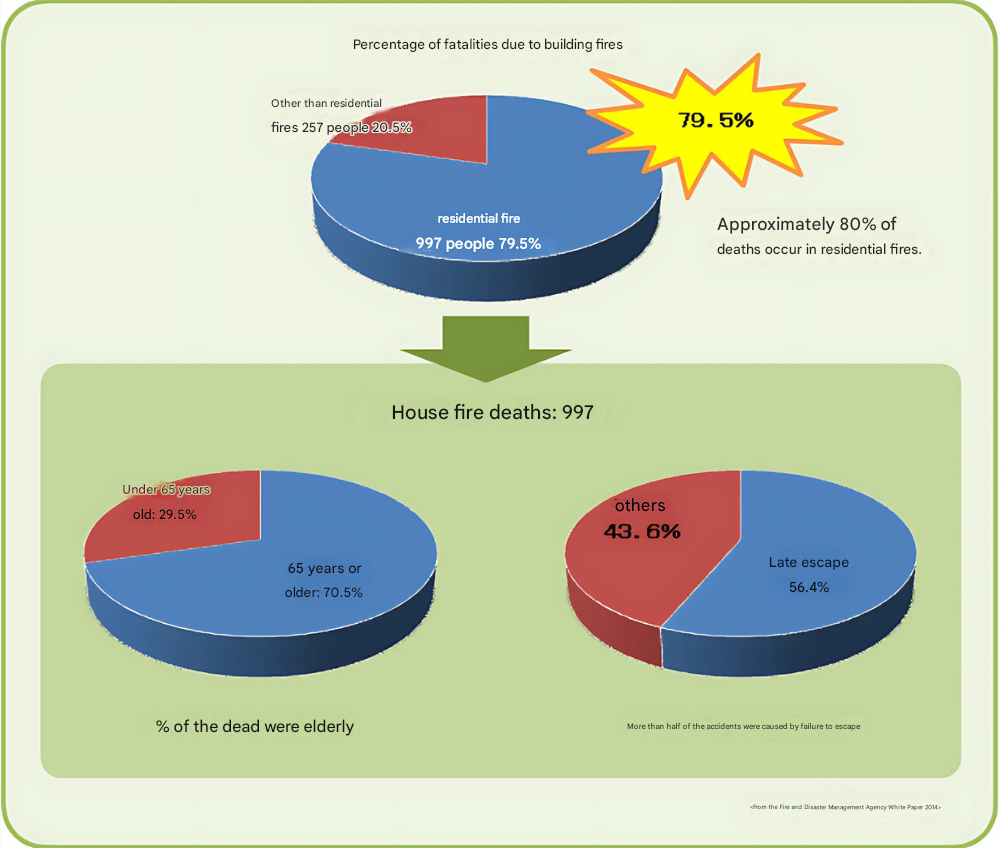
|
|---|
Q: Where will it be installed?
Check the installation location of your residential fire alarm.
*Depending on city or town ordinances, you may be required to install it in other locations.
You can check with the fire department that has jurisdiction over your home.
|
1) First, check the bedroom It is installed on the ceiling or wall of a room used as a bedroom. A bedroom is a room where you usually sleep, and includes the master bedroom as well as children's rooms. However, it does not include guest rooms where guests sometimes sleep. |

|
|---|---|
|
2) Next, check the stairs It should be installed on the ceiling or wall of the landing of the stairs leading from the bedroom floor to the evacuation floor (excluding evacuation floors [floors from which evacuation is easy, such as the first floor]). |

|
|
3) Check further for buildings with 3 or more floors If there are two or more consecutive floors of rooms not used for sleeping on which a residential fire alarm is not installed, the residential fire alarm should be installed on the staircase of the floor where the rooms are located, two floors away from the floor on which the residential fire alarm is installed. |

|
|
4) If you are on a floor where you do not need to install a residential fire alarm, check the last step. Floors that did not require the installation of residential fire alarms in previous inspections but have five or more rooms of 7m² (four and a half tatami mats) or more are now required to have residential fire alarms installed in their hallways. |
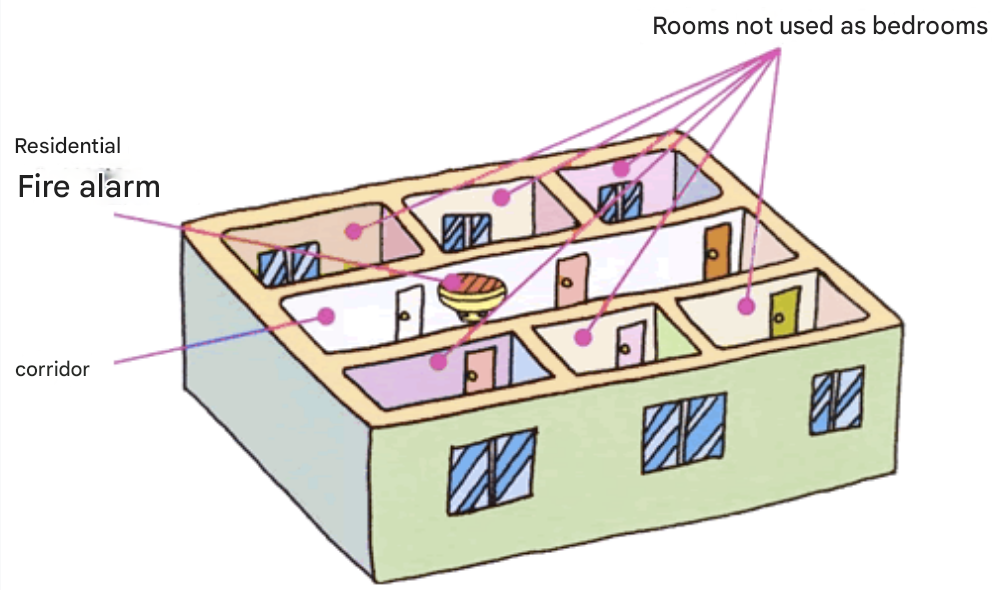
|
Q:Where can I purchase it?
List of Residential Fire Alarm Retailers
(Inc.)Jump to the Japan Fire Alarm Manufacturers Association website.
Gas Alarm Manufacturers
AssociationJump to the Gas Alarm Manufacturers Association website.
You can also purchase them at your local hardware store or electronics store.
Prices vary depending on the manufacturer, type, features, etc.
Q: What types are there?
Here we will introduce some typical residential fire alarms.
|
Photoelectric residential disaster prevention alarm (smoke type) Bedrooms, stairwells, kitchens, etc. |
When smoke that is generated from the early stages of a fire enters a residential fire alarm, it will alert you to the occurrence of a fire with a sound or voice. *Fire prevention laws require that residential fire alarms that detect smoke (smoke type) be installed in bedrooms and stairwells. 
|
|---|---|
|
Constant temperature residential fire alarm (heat type) Kitchen, garage, etc. |
When the temperature around the residential fire alarm reaches a certain level due to the heat generated by the fire, it will sound or sound to notify you of the occurrence of a fire. * Suitable for places where a large amount of smoke or steam circulates, such as kitchens and garages. |
| Gas leak alarm combination |
This is a combination type alarm that incorporates a gas leak alarm that detects gas leaks and sounds an alarm into a residential fire alarm. Some also have a function that sounds an alarm when gas is completely burned. The gas leak detection function unit or incomplete combustion detection function unit is certified by the Japan Gas Appliance Inspection Association or the High Pressure Gas Safety Institute of Japan. |
Power supply method
-
External power supply method
An external power supply system is one in which the power for the alarm is supplied from a source other than a battery. External power supply systems include :
- A system in which power is supplied directly from an outlet in the living room
- A system in which power is supplied directly from a switch in the distribution board
- A system in which power is supplied from the power supply of an auxiliary device
- A system in which power is supplied from another residential fire alarm .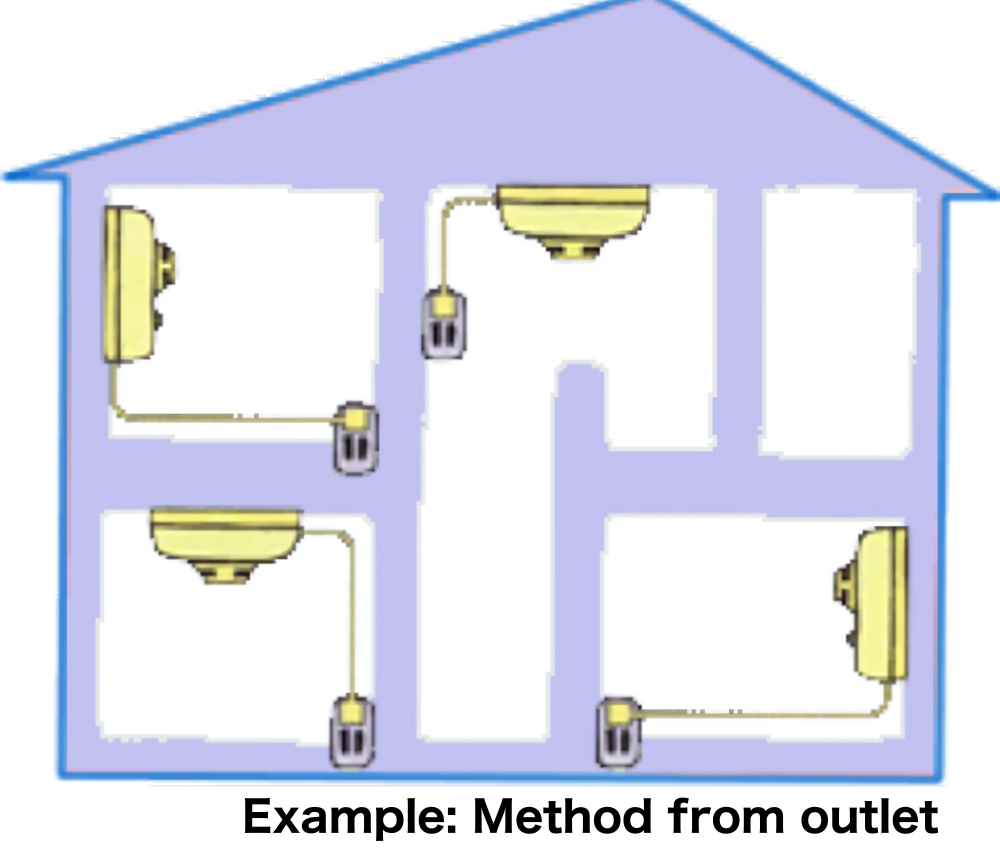
-
Battery Type
A system that uses batteries as the power source for an alarm is called a battery system.
If the installed alarm issues an alarm (sound or light) to indicate that the batteries are running low, replace the batteries.
For alarms that issue an audible alarm when the batteries are low, a simple "beep" sound that repeatedly sounds at intervals of about one minute is recommended. -
Automatic Test Function
This function automatically tests whether the alarm is working properly. If a malfunction occurs in the alarm, it will notify you by sound or display without you having to perform any operations. If a malfunction alarm sounds, replace it with a new alarm.
For an alarm that issues an audible warning of an automatic test abnormality, it is recommended that the alarm beep repeatedly at intervals of about one minute.
"Single" and "linked" types
-
Single type

Only residential fire alarms that detect a fire will sound an alarm.
-
Linked type(hardwired)

Not only the residential fire alarm that detects the fire, but all residential fire alarms that are linked will receive the fire signal and sound an alarm.
-
Linked type(wireless type)

Q: Is inspection necessary?
Maintenance is important for residential fire alarms to function properly.
To ensure that residential fire alarms work properly in the unlikely event of an emergency, be sure to check and maintain them regularly.
-
Exchange
Residential fire alarms have the words "automatic test function" or "replacement due date" written on the front in an easily visible location.
If a fault alarm due to the automatic test function sounds or if the replacement due date has passed, replace the residential fire alarm.
The recommended replacement period is 10 years. -
Display with automatic test function
This function automatically tests whether the alarm is working properly. If a malfunction occurs in the alarm, it will notify you by sound or display without you having to perform any operations.

-
Replacement deadline display
The replacement deadline is calculated based on the reliability of the electronic parts, and the expected dirt on the insect screen and sensor, and is the minimum period during which the device can still function effectively.
Residential fire alarms with automatic testing functions can omit the replacement deadline indication.
Gas leak alarm combination devices also have an "expiration date" indicated instead of a replacement deadline.
Aerosol-type simple fire extinguisher
Extinguish a fire in its early stages

Aerosol type simple fire extinguishers extinguish fires by spraying extinguishing agents in a mist form using the pressure of liquefied or compressed gas. They are effective for fires in the relatively early stages, such as fires caused by overheating oil in a deep fryer in the home, fires caused by ignition while adding oil to a kerosene stove, and wastebasket fires caused by careless handling of fire.
Q: What is the difference between an aerosol type simple fire extinguisher and a fire extinguisher?
Although aerosol-type portable fire extinguishers do not have the same capabilities as residential fire extinguishers, technical standards are established separately from those for fire extinguishers with regard to the effectiveness of initial extinguishing of fires from oil stoves, frying oil, etc. in the home, and the safety of extinguishing agents to the human body.
Our association performs quality evaluations of aerosol-type portable fire extinguishers that are requested of us.
Q.What is the structure and mechanism of an aerosol type simple fire extinguisher?
The products that met the criteria for our evaluation have almost the same structure as aerosol products used in homes, such as hairspray.
They can be operated with one hand and contain a fire extinguishing agent and pressurized gas for spraying. The fire extinguishing agent cannot be refilled and is a disposable type.
Q: What do you consider when choosing?
Please check the "fire protection symbol" that matches your intended use.
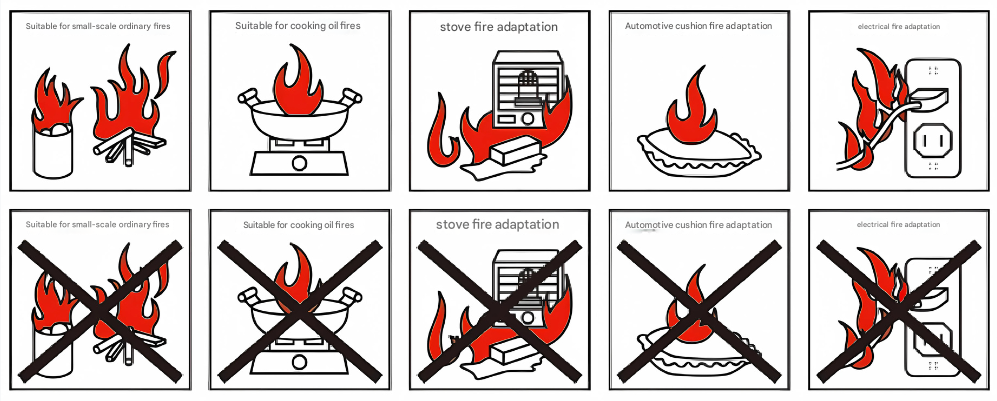
Q: Are there any precautions to take when using or storing it?
Do not reuse a fire extinguisher that has been used once, as there may be insufficient extinguishing agent or the pressurized gas may escape naturally.
When storing, avoid direct sunlight and moisture, and store within the temperature range of approximately 0°C to 40°C.
If you have used the extinguisher or the expiration date (indicated on the container) has passed, you must dispose of it appropriately, such as by draining the contents according to the label, and dispose of it according to the instructions of the local government.
Notes
Aerosol-type simple fire extinguishers are effective in extinguishing fires in the very early stages of fires such as those caused by cooking oil or kerosene stoves that sometimes occur in the home. However, they are not intended to be a substitute for fire extinguishers, but rather are expected to be effective as a supplementary device.What should I do? Fire extinguishing equipment in my home
|
Regarding aerosol type simple fire extinguishers, those that do not have the following markings cannot be sold after April 1, 2017. However, some aerosol type simple fire extinguishers sold before March 31, 2017 do not have this markings. When purchasing an aerosol type simple fire extinguisher, choose one that has the following markings, which prove that it has been commissioned and passed the evaluation by the Japan Fire Equipment Inspection Association. |

|
|---|
-
How to purchase and use
We will provide an easy-to-understand explanation of the importance of fire extinguishers, where to purchase them reliably, and how to use them properly.
-
Storage and disposal methods
We will introduce you to safe storage locations, inspection methods, and detailed disposal methods.
Residential fire extinguishers
Extinguish a fire in its early stages

Fire extinguishers allow firefighters to safely and reliably extinguish fires in their early stages, and they apply the principles of suffocation and cooling, two of the three fire-extinguishing actions. There are two types of fire extinguishers: "residential fire extinguishers" that are installed in ordinary homes, etc., and "commercial fire extinguishers" that are installed in places where installation is required by fire service laws and regulations.
Q.What is the difference between a residential fire extinguisher and a commercial fire extinguisher?
[Residential (household) fire extinguishers]
- Suitable for use on cooking oil fires and stove fires
- Compact and easy to operate for women and the elderly
- No restrictions on the color of the main container (many are colorful or have stylish designs)
- Service life is approximately 5 years
- Chemicals cannot be refilled
[Commercial fire extinguishers]
- Better extinguishing ability and range of use than household extinguishers
- Legal inspection required every 6 months (if installed in a fire-prevention object)
- Inspection must be performed by a qualified person (voluntary inspection is possible for a certain period of time)
- Color of the main container is restricted (more than 25% is red)
- Service life is 8 to 10 years
- Chemicals can be refilled
Q: What do you consider when choosing?
|
A common type of fire extinguisher is a pressurized type. Among them, there are pressurized type fire extinguishers and stored pressure type fire extinguishers. Residential fire extinguishers are of the stored pressure type. |
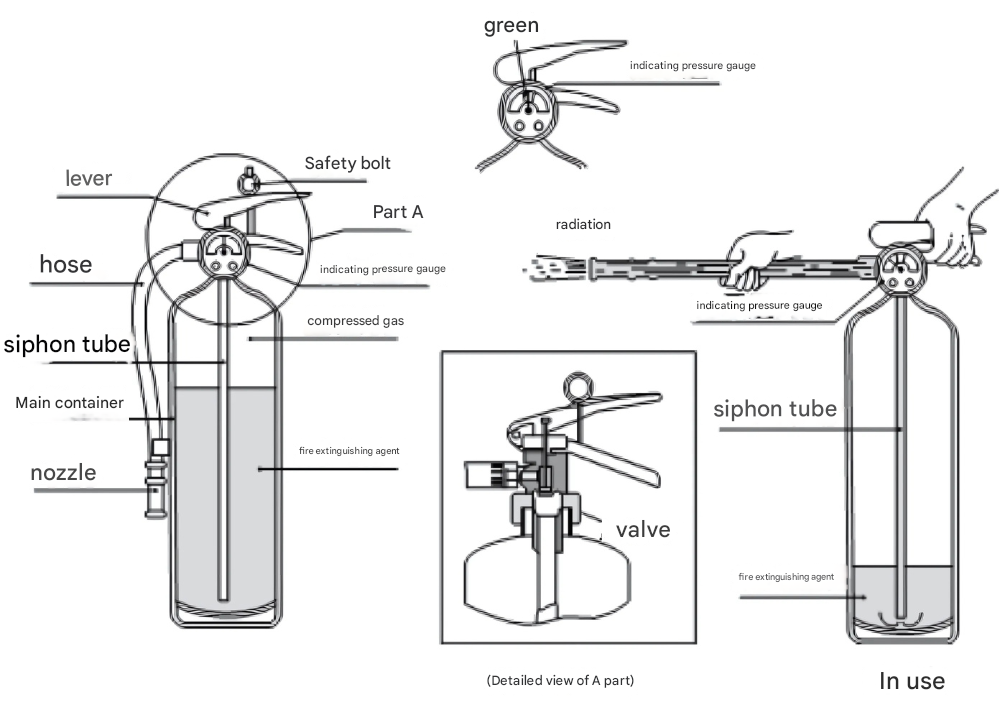
|
|---|
Q: What do you consider when choosing?
・Check the applicable fire type.
・Check that the certification body's mark is attached.
・Check that it is labeled as a residential fire extinguisher.
Q: Are there any precautions to take when using or storing it?
・Fire extinguishers are tools for initial fire extinguishing. They have a limited range.
・Extinguish the fire while securing an evacuation route.
・Avoid installing the extinguisher in a place where it will be difficult to retrieve in an emergency, such as a closet.
・Do not install the extinguisher in a place that is prone to corrosion, humid, or exposed to sea breezes, rain, or wind.
Notes
There is no legal obligation to install fire extinguishers or to conduct legal inspections in ordinary homes, but please regularly inspect them according to the instruction manual.Also, please be aware that there have been reports of unscrupulous businesses posing as specialists making door-to-door sales to forcefully sell fire extinguishers (lease contracts, etc.) and charging exorbitant inspection and removal fees.

 JP
JP